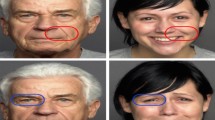Abstract
In this paper we tackle the problem of expression recognition by exploiting age-related spatial facial expression patterns, which carry crucial information that have not been thoroughly exploited. First, we conduct two statistic hypothesis tests to investigate age effect on the spatial patterns of expressions and on facial expression recognition respectively. Second, we propose two methods to recognize expressions by modeling age-related spatial facial expression patterns. One is a three-node Bayesian Network to classify expressions with the help of age from person-independent geometric features. The other is to construct multiple Bayesian networks to explicitly capture the spatial facial expression patterns for different ages. For both methods, age information is used as privileged information, which is only available during training, and is exploited during training to construct a better classifier. Statistic analyses on two benchmark databases, i.e. the Lifespan and the FACES, verify the age effect on spatial patterns of expressions and on facial expression recognition. Experimental results of expression recognition demonstrate the effectiveness of the proposed methods in modelling age-related spatial patterns as well as their superior expression recognition performance to existing approaches.





Similar content being viewed by others
References
Alnajar F, Lou Z, Alvarez J, Gevers T Expression-invariant age estimation
Bayramoglu N, Zhao G, Pietikainen M (2013) Cs-3dlbp and geometry based person independent 3d facial action unit detection. In: 2013 International Conference on Biometrics (ICB). IEEE, pp 1–6
Bennett J, Fisher RA (1995) Statistical methods, experimental design, and scientific inference. Oxford University Press
Bøttcher SG, Dethlefsen C Deal: a package for learning bayesian networks
Cooper GF, Herskovits E (1992) A bayesian method for the induction of probabilistic networks from data. Mach Learn 9(4):309–347
Dibeklioglu H, Salah AA, Gevers T (2015) Recognition of genuine smiles. IEEE Trans Multimedia 17(3):279–294
Ebner NC, Johnson MK (2010) Age-group differences in interference from young and older emotional faces. Cognition and Emotion 24(7):1095–1116
Ebner NC, Riediger M, Lindenberger U (2010) Faces-a database of facial expressions in young, middle-aged, and older women and men: development and validation. Behav Res Methods 42(1):351–362
Ekman P (1993) Facial expression and emotion. American psychologist 48(4):384
Fölster M, Hess U, Werheid K (2014) Facial age affects emotional expression decoding. Frontiers in psychology, vol 5
Guo G, Guo R, Li X (2013) Facial expression recognition influenced by human aging
Heckerman D (2008) A tutorial on learning with bayesian networks. In: Innovations in Bayesian Networks. Springer, pp 33–82
Hess U, Adams RB, Simard A, Stevenson MT, Kleck RE (2012) Smiling and sad wrinkles: Age-related changes in the face and the perception of emotions and intentions. J Exp Soc Psychol 48(6):1377–1380
Houstis O, Kiliaridis S (2009) Gender and age differences in facial expressions. Eur J Orthod 31(5):459–466
John PWM, John PW (1971) Statistical design and analysis of experiments. SIAM
Koller D, Friedman N (2009) Probabilistic graphical models: principles and techniques. MIT press
Lee Y, Lin Y, Wahba G (2001) Multicategory support vector machines. In: Proceedings of the 33rd Symposium on the Interface. Citeseer
Lucey P, Cohn JF, Kanade T, Saragih J, Ambadar Z, Matthews I (2010) The extended cohn-kanade dataset (ck+): a complete dataset for action unit and emotion-specified expression. In: 2010 IEEE Computer Society Conference on Computer Vision and Pattern Recognition Workshops (CVPRW). IEEE, pp 94–101
Minear M, Park DC (2004) A lifespan database of adult facial stimuli. Behav Res Methods Instrum Comput 36(4):630–633
Pantic M, Rothkrantz LJM (2000) Automatic analysis of facial expressions: the state of the art. IEEE Trans Pattern Anal Mach Intell 22(12):1424–1445
Shan W, Shangfei W, Jun W (2015) Enhanced facial expression recognition by age. FG2015 accepted
Siegel S (1956) Nonparametric statistics for the behavioral sciences
Vapnik V, Vashist A (2009) A new learning paradigm: learning using privileged information. Neural Netw 22(5):544–557
Zeng Z, Pantic M, Roisman GI, Huang TS (2009) A survey of affect recognition methods: Audio, visual, and spontaneous expressions. IEEE Trans Pattern Anal Mach Intell 31(1):39–58
Author information
Authors and Affiliations
Corresponding author
Rights and permissions
About this article
Cite this article
Wang, S., Wu, S., Gao, Z. et al. Facial expression recognition through modeling age-related spatial patterns. Multimed Tools Appl 75, 3937–3954 (2016). https://doi.org/10.1007/s11042-015-3107-2
Received:
Revised:
Accepted:
Published:
Issue Date:
DOI: https://doi.org/10.1007/s11042-015-3107-2




